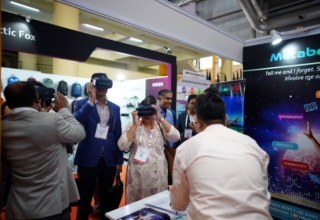
A team of international astronomers has discovered a giant planet orbiting a nearby star similar to our own Sun. The planet, Epsilon Indi Ab, or Eps Ind Ab for short, is classified as a ‘super-Jupiter’ due to its mass, which exceeds that of Jupiter by at least six times, making it significantly larger than any planet in our solar system.
The newly discovered planet is located 12 light-years away from us. The planet is quite cold, with a temperature of about -1°C (30°F). Its orbit is also immense, circling its star at a distance 28 times greater than the distance between our Earth and the Sun.
Eps Ind Ab is the first-ever mature exoplanet (a planet beyond our solar system) to be discovered using direct imaging technique. The details of the discovery and the research behind it has been published in the world’s leading multidisciplinary science journal, Nature.
Using the James Webb Space Telescope’s (JWSTs) Mid-InfraRed Instrument (MIRI), an international team of astronomers has directly imaged a new exoplanet orbiting the K5V-type star Epsilon Indi A (also known as HD 209100 or HIP 108870). Direct imaging of a nearby mature exoplanet marks a significant milestone in the realm of space exploration. Unlike indirect methods that infer a planet’s existence through its gravitational influence or the dimming of starlight as it passes in front of its host star, direct imaging allows astronomers to directly observe the exoplanet itself. This breakthrough shows the incredible capabilities of the JWST with its unique combination of high sensitivity, infrared capabilities, and advanced imaging techniques. Such advancements pave the way for future discoveries and deepen our quest to uncover the mysteries of distant worlds.
Dr. Prashant Pathak, Assistant Professor, Dept. of Space, Planetary & Astronomical Sciences & Engineering (SPASE), IIT Kanpur and a key member of the research team, explained, “This discovery is exciting because it gives us a chance to learn more about planets that are very different from our own. The planet’s atmosphere appears to have an unusual composition that indicates a high metal content and a different carbon-to-oxygen ratio than we see on our own solar system planets. This opens up fascinating questions about its formation and evolution. By studying Eps Ind Ab and other nearby exoplanets, we hope to gain a deeper understanding of planetary formation, atmospheric composition, and the potential for life beyond our solar system.”
Elisabeth Matthews, a researcher at the Max Planck Institute for Astronomy in Heidelberg, Germany and the lead author of the research article said: “To our surprise, the bright spot that appeared in our MIRI images did not match the position we were expecting for the planet”, Matthews points out. “Previous studies had correctly identified a planet in this system but underestimated mass and orbital separation. With the help of the JWST, the team was able to set the record straight.”
This work is only a first step towards characterising Eps Ind Ab. “Our next goal is to obtain spectra which provide us a detailed fingerprint of the planet’s climatology and chemical composition,” said Thomas Henning, Emeritus Director at MPIA, co-PI of the MIRI instrument, and a co-author of the underlying article. “In the long run, we hope to also observe other nearby planetary systems to hunt for cold gas giants that may have escaped detection. Such a survey would serve as the basis for a better understanding of how gas planets form and evolve.”
The team of researchers from renowned institutions around the world included Elisabeth Matthews, Max Planck Institute for Astronomy, Germany; Aarynn Carter, Space Telescope Science Institute, USA; Prashant Pathak, Department of SPASE, Indian Institute of Technology Kanpur, India; Caroline Morley, Department of Astronomy, USA; Mark Phillips, Institute for Astronomy, University of Edinburgh, UK; Sai Krishanth Pulikesi Mannan, Steward Observatory and Department of Astronomy, USA; Fabo Feng, Shanghai Jiao Tong University, People’s Republic Of China; Markus Bonse, ETH Zurich, Institute for Particle Physics & Astrophysics, Switzerland / Max Planck Institute for Intelligent Systems, Germany; Leindert Boogaard, Max Planck Institute for Astronomy, Germany; Jennifer Burt, Jet Propulsion Laboratory, California Institute of Technology, USA; Ian Crossfield, Department of Physics and Astronomy, University of Kansas, USA; Ewan Douglas, Steward Observatory and Department of Astronomy, USA; Thomas Henning, Max Planck Institute for Astronomy, Germany; Justin Hom, Steward Observatory and Department of Astronomy, USA; Markus Kasper, European Southern Observatory, Garching bei München, Germany; Chia-Lin Ko, Steward Observatory and Department of Astronomy, USA; Anne-Marie Lagrange, LESIA, Observatoire de Paris, Université PSL, CNRS, France / Univ. Grenoble Alpes, CNRS-INSU, Institut de Planétologie et d’Astrophysique de Grenoble (IPAG), France; Dominique Petit dit de la Roche, Department of Astronomy, University of Geneva, Switzerland; and Florian Philipot, LESIA, Observatoire de Paris, Université PSL, CNRS, France.










